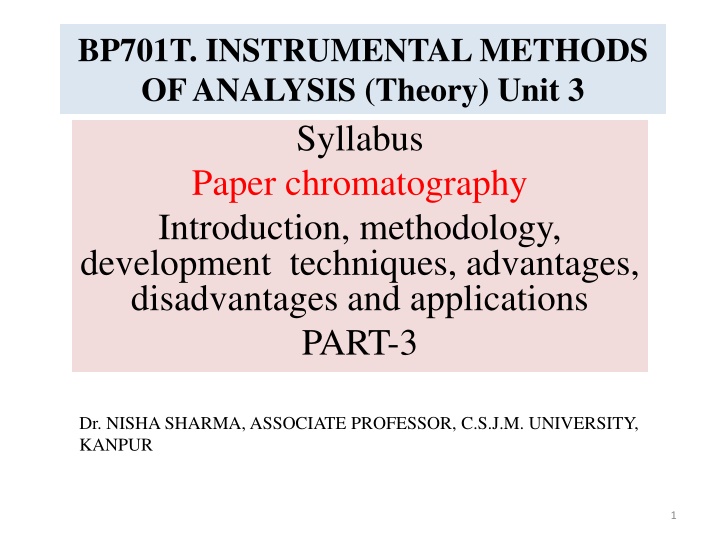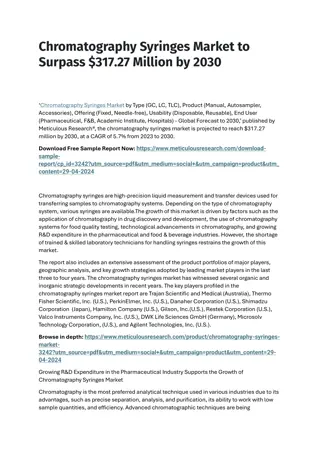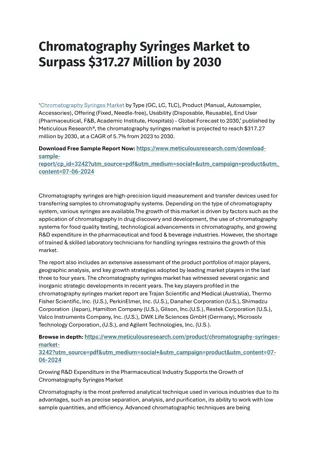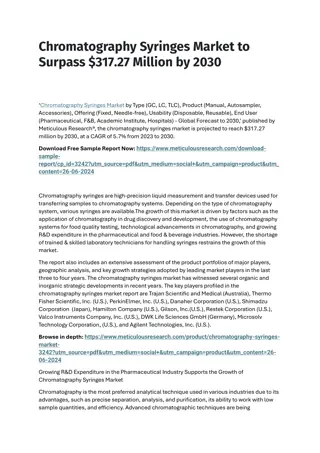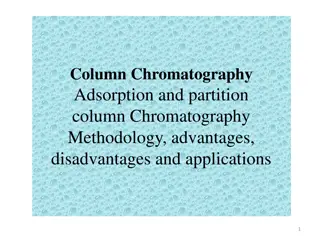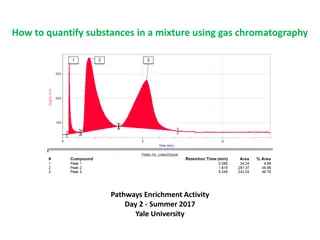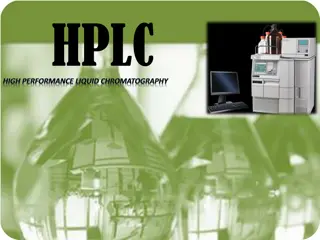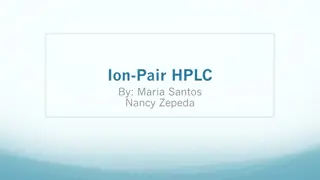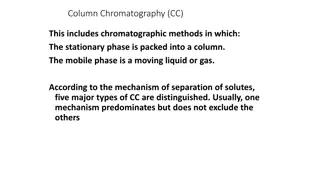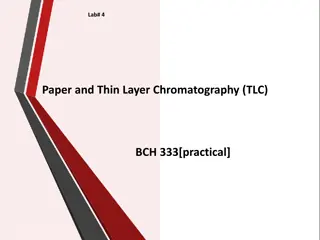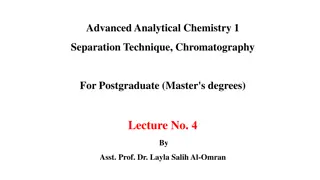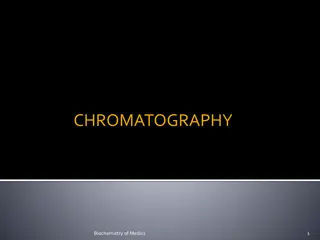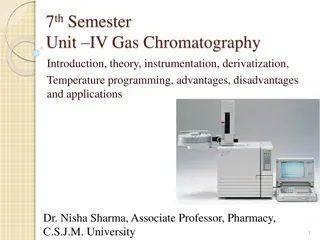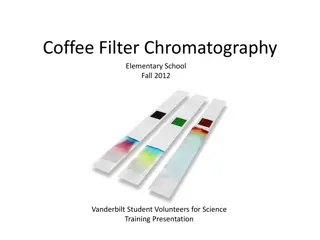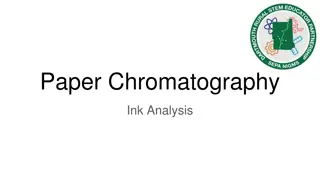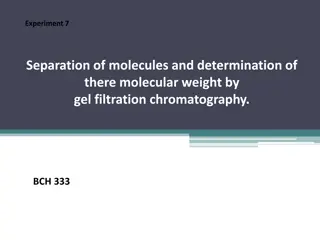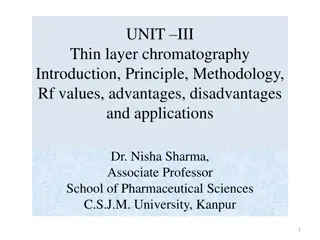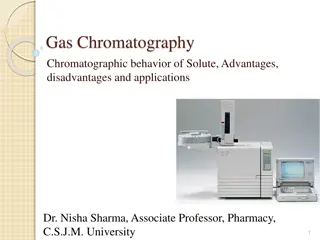Chromatography Development Techniques and Applications - Part 3
This section covers the development techniques in chromatography, including the preparation of samples, spotting, tank saturation, drying the chromatogram, and visualization/detection methods. It also discusses the calculation of Rf values and the estimation process after extraction from paper. Detailed steps and procedures are provided alongside images for better understanding.
Download Presentation

Please find below an Image/Link to download the presentation.
The content on the website is provided AS IS for your information and personal use only. It may not be sold, licensed, or shared on other websites without obtaining consent from the author.If you encounter any issues during the download, it is possible that the publisher has removed the file from their server.
You are allowed to download the files provided on this website for personal or commercial use, subject to the condition that they are used lawfully. All files are the property of their respective owners.
The content on the website is provided AS IS for your information and personal use only. It may not be sold, licensed, or shared on other websites without obtaining consent from the author.
E N D
Presentation Transcript
BP701T. INSTRUMENTAL METHODS OF ANALYSIS (Theory) Unit 3 Syllabus Paper chromatography Introduction, methodology, development techniques, advantages, disadvantages and applications PART-3 Dr. NISHA SHARMA, ASSOCIATE PROFESSOR, C.S.J.M. UNIVERSITY, KANPUR 1
4. DEVELOPMENT (Preparation of samples) No standard procedure Because of presence of variety of components like fats, salts, proteins etc. Sample volume of 10-20 l containing few g of sample is ideal sample 2
5. DEVELOPMENT (Spotting) For ascending technique : 24cm x7cm whatman paper Graduated micro pipette for sampling the spots Drying by stream of hot or cold air 6.Preparing the tank/ chamber The chamber is loaded with selected solvent mixture and poured in to the chamber such that the level of solvent is about 1 cm from bottom. 3
7. Saturation of tank: After placing solvent system, hang a blotting paper by the sides of tank and allow the solvent to rise to top. 8. Placing the paper in to the chamber: With the help of clips/holder hang the paper in to chamber such that the edge of the paper just touches the edge of solvent layer. 8. Allow to run the solvent onto paper till top but before the other edge. 4
9. Drying the chromatogram: Oven, drying cabinets with temp. control 10. Visualization/Detection: Done by Chemical : Chromogenic / visualizing /locating agent: By dipping or fine spray atomizer or I2 vapours used in cupboard 5
Detection Physical method: colorless spots- under U.V. lamp- fluorescence reveals the presence Irradiation with light of 254nm for compounds that absorbs in U.V. range 365nm : the fluorescence before and after irradiation with shorter wavelength light 6
11. Calculation of Rf 12. Estimation : After extraction from paper Isolation of separated components from paper Cut the spot part of paper, soak in min. qty. of solvent Semi micro extractor (soxhlet), Eluation 7
Estimation After extraction from paper Determine by U.V. spec., colorimetry, Flourimetry, Flame photometry, conductometry etc. Factors: Nature of subs., equipment avail., senstivity of method, time etc. In situ methods for estimation a. By visual assessment: By human eye- not quantitative 8
b. Measurement of areas: Size of spot: Det. Qty. of subs., Linera relation obtained b/w spot area & amt. of subs. Present Random errors: spot shape, vol. applied, speed of application must be identical 3. By densitometer: Intensity of color of subs. Measured directly on chromatogram 4. Potentiometry: changes in potential of metal electrode in contact with filter paper 9
ADVANTAGES Low cost Requires less quantitative material Very efficient for polar substances Easy to handle Both inorganic and organic compounds can be identified Simple Various modes are available Quantitation is possible 10
DISADVANTAGES Cannot separate complex mixtures Quantification is not efficient Takes more time- 2-3 hr. Accuracy is less Results on paper cant be stored for long time Separation is not sharp Corrosive chemicals destroy paper U.V. chamber can be used for florescent compounds only 11
APPLICATIONS To monitor the reaction To check purity of pharmaceuticals In fermentation and ripening Analysis of reaction mix. in biochemical labs Forensic testing Beverages and food industry Analysis of Cosmetics Drug testing Separation of carbohydrates, antibiotics, amino acids, vitamins, mix. of drugs etc. 12
